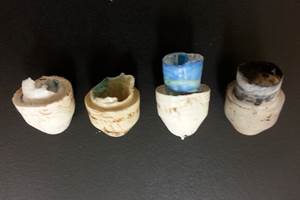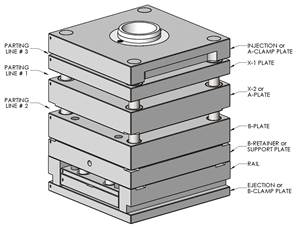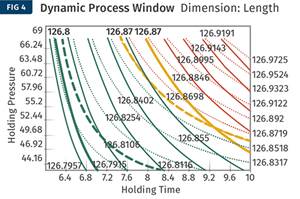Share
Read Next
Denny Reiland is CEO and third-generation owner of General Pattern in Blaine, Minnesota. Though the company originated as a foundry pattern maker, its “óĻó“«Ć½ today is largely the production of injection molded parts (examples in the banner above) using tooling produced in house.
“We are not a quarterly company,” says Denny Reiland, third-generation owner and CEO of Minnesota-based manufacturer . “We are a decades company.”
That long-view perspective has shaped General Pattern’s evolution over its 103 years, from its founding in pattern making to its current role as a custom plastic specialist.
Today, a small but growing fraction of that mold tooling is being 3D printed.
Where other long-tenured manufacturers might have become hesitant or stagnant, General Pattern has embraced change and reimagined itself multiple times over the decades. That reimagining has sometimes meant abandoning markets that no longer make “óĻó“«Ć½ sense. But it has also meant bravely stepping into new ones, and adopting the right technologies to serve them.
Additive manufacturing (AM) is one such technology. While General Pattern has been using 3D printing for prototyping since the 1980s, the company held off on deeper implementation of AM until the technology felt more mature. Today, General Pattern has embraced several types of additive manufacturing to produce tooling for its injection molding services, alongside conventional moldmaking. I visited the company’s Minnesota campus late last year to learn how General Pattern is applying 3D printing technology to support its tooling needs today, and the role AM could play in its future decades.
Molding and Moldmaking, Vertically Integrated
General Pattern has seen plenty of change in its century-plus history. The company, founded in 1922 by Reiland’s grandfather, began as a pattern-making “óĻó“«Ć½ to support foundries. When casting work began moving overseas in the 1970s, the company took the skillsets it had acquired in pattern making and pivoted into the related field of model making, this time for the toy industry.
General Pattern operates 62 CNC milling machines to manufacture the mold tooling required to keep its 85 presses running.
That pivot also brought about an acceleration in the company’s typical delivery timelines, as toys typically go from concept to product in stores in less than a year to meet the holiday rush. Driven by customer needs, General Pattern soon jumped from model making into injection molding of parts to support the toy market. Keeping up with the pace of product development also necessitated producing the mold tooling to be able to deliver parts within a matter of weeks.
Supporting product development has continued to be a significant part of the company’s activity. General Pattern adopted its first 3D printer in 1987 to help automate modeling and keep up with demand for rapid product development and prototyping. This responsiveness and willingness to iterate quickly with customers on new products has remained a core capability, even as part-producing through injection molding has grown to the largest share of the company’s “óĻó“«Ć½, supported today entirely by tooling made in-house.
Marcy Krosch (right) is senior vice president of sales for General Pattern. Part of her role is consulting to determine which of the company’s 16 different injection mold tooling solutions fit with each customer’s needs, including several different 3D printed tool options.
Product development is a step on the way to winning the scale production work, and beginning to collaborate with the customer on a new product or part in its prototype stage helps with the workflow later, when “we have to live with production,” Reiland says, explaining that this collaboration entails not just working out technical details but establishing trust as well. “Part of prototyping is the relationship that we build.”
The Long View Looks Toward Additive
The road from pattern making to vertically-integrated injection molding hasn’t been a straight one, but over the last few decades molding has proven to be an enduring “óĻó“«Ć½. With each new customer and opportunity, General Pattern aims to take the long view. Rather than quick transactions, the company embraces opportunities where it can become a long-term production partner for the customer, ideally for multiple projects.
“Once the trust is earned, we work with the customer to support the multiple needs of our wide breadth of service,” Reiland says, describing how one job frequently leads to more with established customers. It’s been a successful strategy; the company’s top 10 customers have all been using its services for more than 20 years.
Longevity carries through within the company as well. Today, Reiland works alongside his daughter Staci Thill, president and part of the fourth generation of family to lead the “óĻó“«Ć½. Average employee retention is 14 years, and some employees have even been with the company since the pattern-making days.
General Pattern currently occupies 18 buildings in Blaine, Minnesota, and also owns a plant in Indiana. The company’s 85 molding presses cover injection molding at all scales — low, medium and high volume — as well as urethane casting, foam injection molding, rotary molding, and various finishing operations including painting and assembly.
Staci Thill (center) and Denny Reiland represent the fourth- and third-generation of family to run General Pattern. Vertical integration has been a company-wide goal at least since it entered into injection molding. The molded part Reiland is holding features round metal inserts — the company added turning capacity just so it could produce components like this in-house rather than relying on a supplier.
On top of all this, the company continues to manufacture all its own tooling in-house. The company operates 62 CNC milling centers, many of which are dedicated to producing mold bases, cavities and inserts. Of its 200 employees, 10% are full-time toolmakers.
These experienced professionals have been incredibly important to General Pattern’s growth and ability to quickly develop and produce molded products. But the toolmaking workforce is aging, and there aren’t enough young people in training to fully replace what will be lost when they retire. Therefore, General Pattern has been keenly watching new technologies including computer vision and 3D printing to bridge potential gaps and shore up its capacity for the future.
3D Printing As the Toolmaker’s Reinforcement
General Pattern is farthest along with the latter technology, 3D printing, as an augment to its existing toolmaking workforce and capacity.
After watching the market for some time and experiencing frustration with laser powder bed fusion (LPBF) tooling for its postprocessing needs (“If you gotta cut it anyway, you might as well cut it to begin with,” Reiland says), General Pattern made the decision to invest in a different metal 3D printing platform from Mantle.
The Mantle TrueShape 3D printer was busy during my visit 3D printing a set of four molding inserts. The machine extrudes metal paste which it then shapes with milling tools; printed green parts require sintering before use.
This machine in its soft green state; upon sintering in a separate furnace, a printed mold insert made this way can often go straight into a tool, without finish machining or further processing in many cases.
“Moldmakers are a finite resource,” Reiland points out. The addition of the metal 3D printer was a way “to help get more throughput.” And moldmakers have taken to this tool, leveraging it for everything from quick-turn prototype and production molds to inserts for larger tools and design iteration of specific features. (One of the operators of the Mantle platform is actually a pattern maker, someone who has been with the company since before its multiple waves of reinvention.)
A 3D printed tool is generally comparable in cost to one made conventionally, Reiland says. But where the Mantle process shines is making not the full mold, but its most complicated parts — the smaller inserts that provide the detail of the finished part — while the cavity and larger pieces are machined, effectively stretching the capacity of toolmakers. Meanwhile, TrueShape also offers speed; a complete H13 tool steel insert can be produced in just a week, with “amazingly minimal handwork,” Reiland says.
General Pattern actually had the chance to put the process to the test against conventional toolmaking for the mold pictured below. This tool for molding the A-pillar of a truck was initially produced using sinker EDM to create the deep ribs, and features 31 hand picks (or sliding elements for undercuts or recesses). Four toolmakers completed the core, cavity and inserts in about four weeks with about 400 hours of labor. But when the customer came back with an updated redesign, it meant rebuilding the tool from scratch.
This automotive mold featuring 31 hand picks took four toolmakers 400 hours to produce conventionally. When the tool had to be remade, General Pattern used Mantle’s 3D printing process to produce the hand picks (represented by the darker insert here), cutting the production time in half.
This time, General Pattern leveraged the Mantle technology for the hand pick inserts. These pieces took 110 hours to print and 48 hours to sinter, time that mostly left the toolmakers free to focus on the core and cavity. No secondary operations were required on the 3D printed inserts before use. Producing the tool the second time around required only 200 hours and the work of just two toolmakers.
A closer look at the Mantle insert. General Pattern now routinely uses this 3D printing technology to produce complex mold components such as this, as well as for design iteration and changes.
A Dual-Tooling Strategy
While the Mantle platform has been a boon to General Pattern’s toolroom, early product development requires a different technology. The company more recently has been exploring polymer 3D printed tooling using , a technology developed by AddiFab and currently available through Nexa3D.
FIM involves 3D printing mold tooling using Nexa3D’s resin-based 3D printing platform; rather than a permanent tool, however, FIM produces dissolvable, one-time-use tooling. And the platform is fast — a tool can be printed in just one day on the Nexa3D desktop machine that is suitable for use with an 8-ton press. The technique makes it possible to mold parts with complex internal structures, overhangs and geometries that would not be viable with standard injection molding, even during the early development stages.
Freeform Injection Molding (FIM) uses a specialized polymer (seen in blue) to build mold inserts with a DLP process. The inserts are compatible with a wide range of injection molding resins, and can be dissolved out of final parts — making it possible to mold overhangs and other difficult geometries. FIM inserts are also often the cheapest tooling option General Pattern can offer, suitable for short-run and intitial prototype molding.
For General Pattern, the technique also has the advantage of being a fast, efficient path to prototype tooling that is compatible with typical molding materials. The Nexa3D solution offers a way to easily and quickly iterate the product design before cutting (or perhaps 3D printing) a metal tool, allowing prototypes to be made from the same material intended for production. This is particularly useful for customers such as medical device companies; a quicker path to molded parts can accelerate the FDA approval process.
But FIM’s speed pays off for various types of product development. For example, in one instance an engineer from a customer company traveled to General Pattern to see initial prototype molded parts for the chin strap buckle for a child’s helmet but found that the engagement of the buckle wasn’t quite right. He went back to his hotel room to make some CAD adjustments and sent a new design to General Pattern, which then printed new tooling with Nexa3D, and assembled and shot the mold to produce new prototype parts within 24 hours.
Beyond speed, FIM also offers new ways of approaching difficult molding geometries, especially when used in combination with Mantle-printed tooling. This mold for an earbud component is an example.
This “hybrid” tooling solution combines a metal Mantle tool with consumable FIM inserts that enable an undercut feature.
Undercuts in the design required hollows in the tool, which were difficult to 3D print unsupported with the Mantle process. After struggling to achieve the exact geometry with metal printing alone, General Pattern implemented Nexa3D FIM to make smaller lifters that can mold the undercut features as part of the same tool. When the FIM lifters are dissolved out later, the overhang is left standing.
AM for Tooling — And Beyond
With 3D printing capability, General Pattern provides 16 different tooling categories to support injection molding in its separate low, medium, large tonnage and high-scale volume facilities. Tools range from early development and short lead time (the Nexa3D FIM tooling) to the most complex and longest-lived (full steel). General Pattern aims for “volume optimized tooling” (VOT) whereby the selection of tooling material and strategy is matched to the expectation of annual use and longevity of the program.
“We consult on the program and lifespan to match our proposal to best fit the needs of the project and ROI,” explains Marcy Krosch, senior vice president of sales. Sometimes needs change, in which case tooling can be remade or adapted; lower-cost aluminum tooling initially made for smaller volumes can be treated with a Teflon-nickel coating to extend its life rather than remaking the tool in steel, for example.
CNC machining is still the primary way of producing mold tooling at General Pattern, but the company is finding value in leveraging additive manufacturing, particularly the TrueShape process, to produce inserts that might be time-consuming to make otherwise.
“It depends on the quantity, material, timeline and life of the part,” Krosch says. “Having multiple solutions to offer helps us problem-solve with our customer, which is another of our advantages.”
Skipping tooling altogether in favor of production through 3D printing may become a more significant one of those options in the future, though direct printing of parts is only a small part of the “óĻó“«Ć½ today. For quantities of more than 500, General Pattern finds that injection molding, with tooling made through one of its internal processes, is still the way to go. Currently General Pattern offers 3D printing services only to existing customers, and most of this capacity is still dedicated to tooling and functional prototyping.
Injection molded, rather than directly 3D printed, parts take precedence at General Pattern. Still, the company does do some 3D printing of parts, primarily for product development and aftermarket services.
Its HP Multi Jet Fusion 3D printer, for instance, is almost completely dedicated to quick-turn prototyping for clients. For example, a power tool company that frequently iterates new products on a 15-day timeline, has a standing order for time on the machine; each day General Pattern starts a print around 4 p.m. and ships the parts the next day. “Our sense of urgency is the secret sauce,” Reiland says.
Production through 3D printing might look like more of this work: fast, responsive manufacturing to provide small quantities of parts right away. It might also be a way for General Pattern to deliver aftermarket parts or components needed only on an intermittent basis.
Part of the work happening within General Pattern’s quality department currently involves building a library of part information, including scan data, that could be used to meet on-demand production needs.
The company is currently building a library of parts like this using software from Dozuki. For parts designed or adapted for 3D printing that are stored in this database, AM could be a way of filling some of these needs in the future.
“We’re in the process of graduating 3D printing into production,” Reiland says. Currently, there is no immediate rush to jump into direct additive manufacturing of polymer parts. But if the demand comes, and the technology can meet it, General Pattern remains flexible and ready to pivot.
About the Author
Stephanie Hendrixson reports on 3D printing technology and applications as executive editor for . She is also co-host of , a video series that highlights unique, unusual and weird 3D printed parts, and co-host and creator of the .
Related Content
How to Start a Hot-Runner Mold That Has No Tip Insulators
Here's a method to assist with efficient dark-to-light color changes on hot-runner systems that are hot-tipped.
Read MoreDesign Your Tools for Moldability ... and Maintenance
In the initial design phase, when considering the structure and elements of the tool, are you designing them to be maintenance friendly? Canon Virginia has used this approach and preventive maintenance to make tool replacement a thing of the past. You can, too. Here’s how.
Read MoreHow to Design Three-Plate Molds, Part 1
There are many things to consider, and paying attention to the details can help avoid machine downtime and higher maintenance costs, and keep the customer happy.
Read MoreOptimizing Pack & Hold Times for Hot-Runner & Valve-Gated Molds
Using scientific procedures will help you put an end to all that time-consuming trial and error. Part 1 of 2.
Read MoreRead Next
Production 3D printing soared in 2020, brought about by supply chain shortcomings and needs related to the pandemic. More than a year later the scene is different, but The Technology House sees promise ahead.
Metal paste is the starting point for a process using 3D printing, CNC shaping and sintering to deliver precise H13 or P20 steel tooling for plastics injection molding. Peter Zelinski talks through the steps of the process in this video filmed with Mantle equipment.
ReelView Fishing faced an electronics obstacle in the development of its new technology for underwater video. Additive manufacturing for moldmaking allowed for the speed necessary to iterate to a solution. How inventors and invention will benefit from new ways of obtaining production-ready tooling.

.jpg;width=70;height=70;mode=crop)



.jpg)





